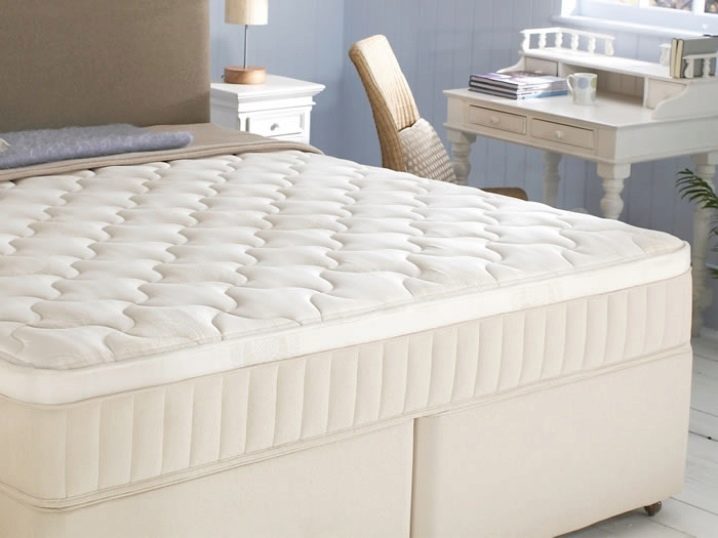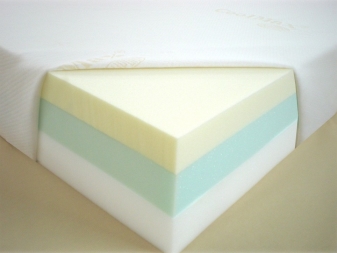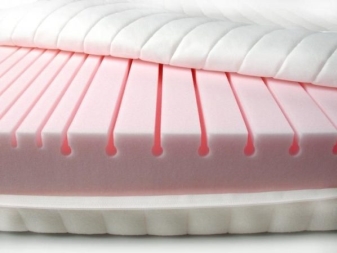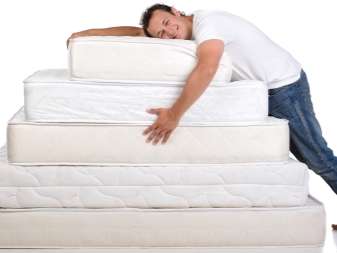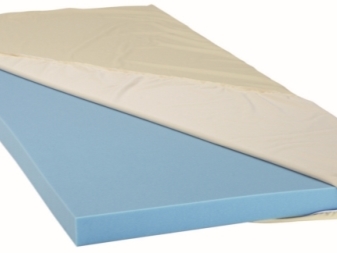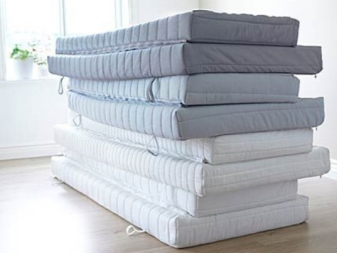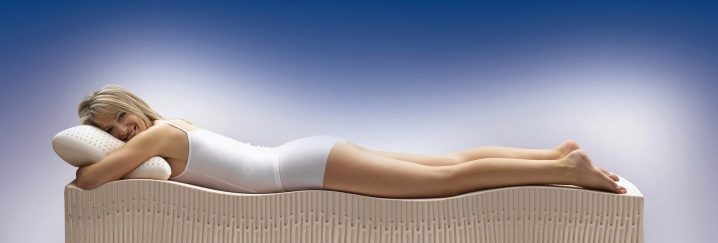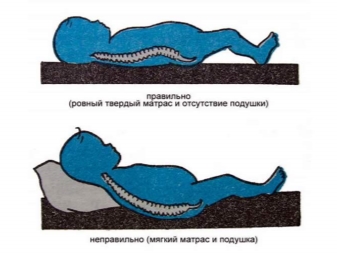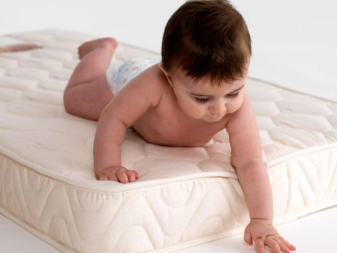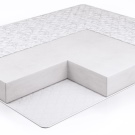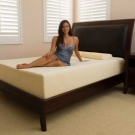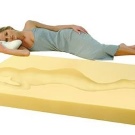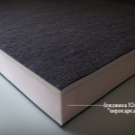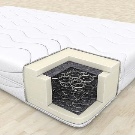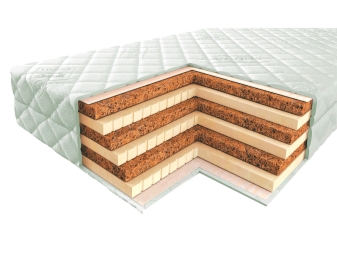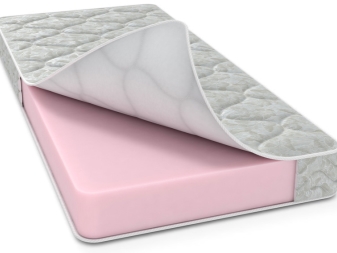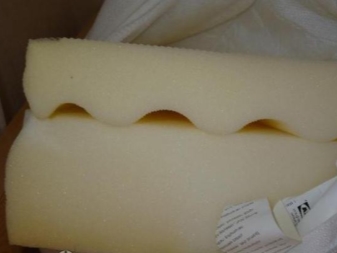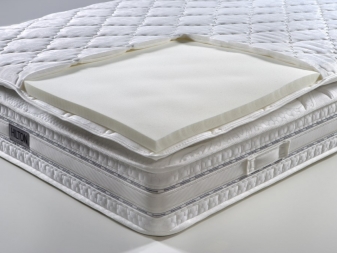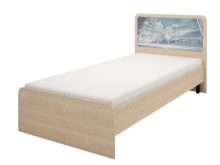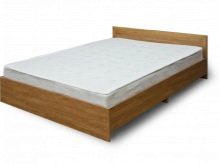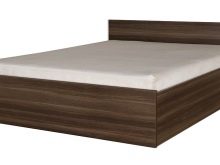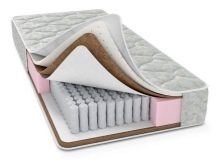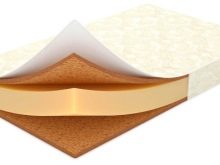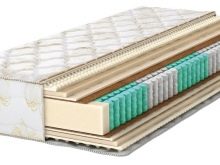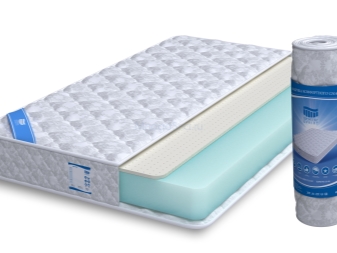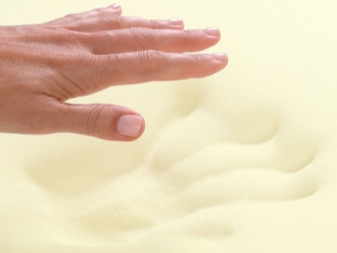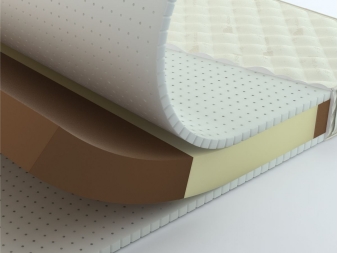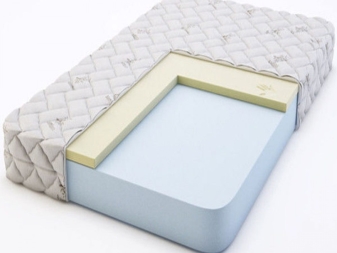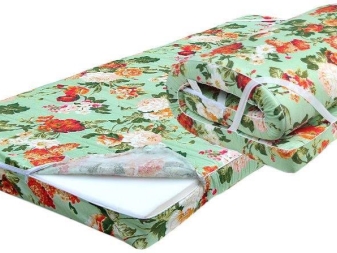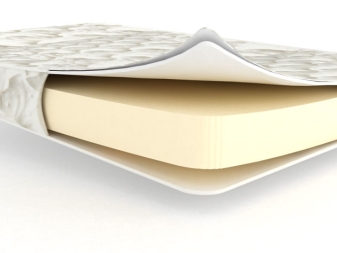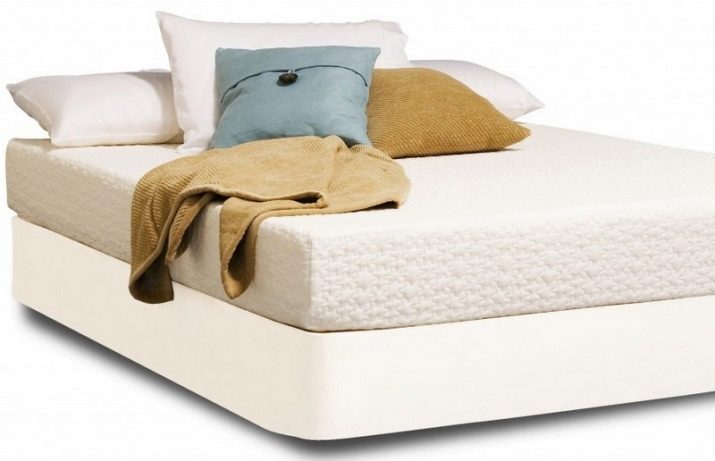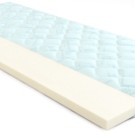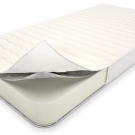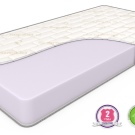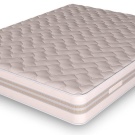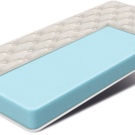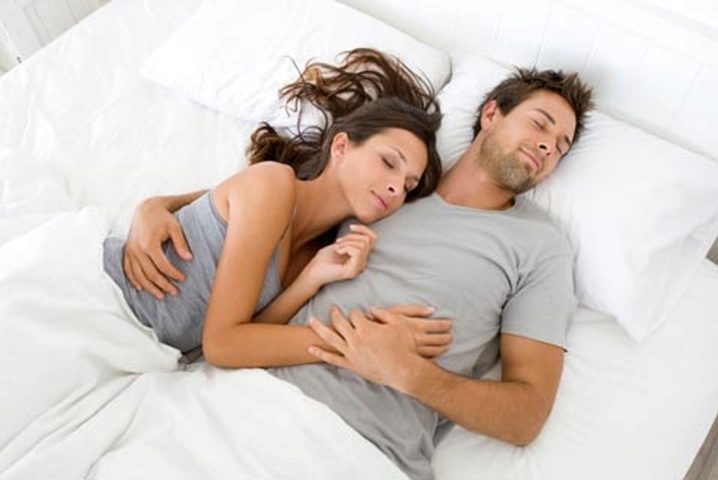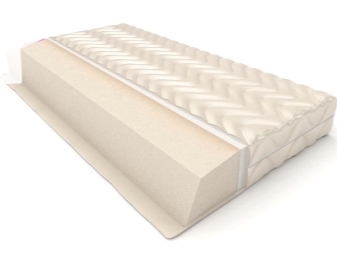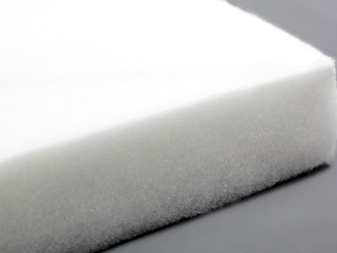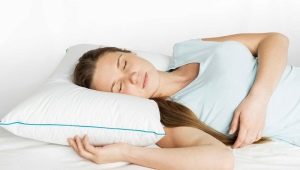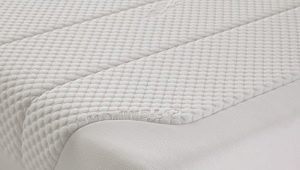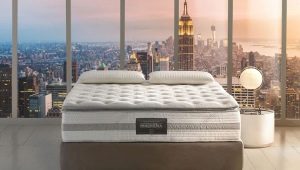Polyurethane foam mattress
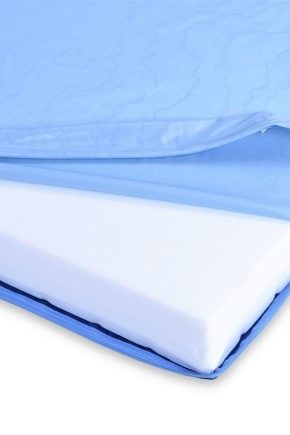
The mattress filler is the main factor determining its qualitative and practical characteristics. To make a person’s sleep as comfortable as possible and the rest to be correct, you need to know all the nuances of the stuffing. Among the variety of models, a polyurethane foam mattress is very popular with customers. It is a worthy alternative to high-quality latex blocks and has a number of differences.
What it is?
Polyurethane foam (PPU for short) is related to gas-filled plastics. To obtain the desired consistency, it is churned and cooled, forming a microcellular material with a homogeneous structure. Visually, it is a solid sponge-like layer of a certain thickness and size. Due to its structure, PPU is characterized by low weight and elasticity.
It is of two types: standard and cast. In the first case, these are the usual soft layers, in the second - special mattresses for high-quality blocks. It is this type of filler that has particular popularity, possessing a number of advantages.
Specifications
Like their counterparts, polyurethane mattresses have strengths and weaknesses. This is a mass of species that differ from each other in shape (rectangular, square, oval), thickness, level and load distribution.
These mattresses have several advantages. They:
- do not irritate the skin of the user, even very sensitive and prone to allergies;
- due to its structure, they have good air exchange, which excludes the formation of an environment for microorganisms (fungus, mold) and the appearance of an unpleasant odor;
- have high rates of elasticity, elasticity and density, quickly return to their original shape (in the absence of a load);
- are safe for the user, practically do not clot, do not rot, although they may slightly change in color along the edges of the mattress;
- depending on the structure of the block, they have different degrees of rigidity (depending on the chosen thickness and density of the layer);
- have a wide range of models designed for different ages of the user (children, adults, elderly, sick people);
- supplemented by different packing, may have an additional effect;
- do not have large voids in the base, therefore they are resistant to dust accumulation;
- developed taking into account the permissible load and a different number of users (for one, two places of two people of average weight);
- supplemented with high-quality textile cover made of natural non-slip fabric;
- based on the type of building and the prices of the components differ in different cost.
These mattresses are suitable for people with high weight. They are optimally soft, therefore they are relevant for those who have pain in the upper spine. Location on such blocks is always convenient and comfortable.
Minuses
Despite the advantages and density, polyurethane foam mattresses can not provide full support for the spine, if they do not have additional solid stuffing. They cannot be called tough: even memorizing the form of the user, their task is comfort, not prevention. Other disadvantages include:
- Due to the spongy structure polyurethane foam block can absorb moisture, which negatively affects its structure and requires periodic ventilation and drying (naturally).
- Another disadvantage of this mattress is the effect of sunlight on the filler itself: no direct hit of the sun on it when it is dried on the balcony or is without a removable cover.
- These mattresses are less durable than latex structures: with daily use they will last a maximum of 8-10 years. Choosing a polyurethane foam sample, it is necessary to focus on the weight of the user, otherwise the service life will be much less.
Health benefits or harm?
Companies and sellers are sure that PU foam mattresses are good for human health, regardless of age. However, in practice polyurethane foam mattresses without an extra layer of stuffing are not able to provide the necessary support to the spine. Even the most immaculate type of memory filler does not have orthopedic properties, like natural latex or coconut coir.
If you want to buy a standing block for many years, you can give preference to other types of stuffing, not sparing money for your health. If you want to save, you can lose more.
For a child, such a mattress is contraindicated, as if the manufacturers did not prove the opposite. The whole point here is the need for a solid foundation in order for the spinal curvatures to form correctly (which polyurethane foam cannot provide for itself). If we consider that the back is formed almost until adulthood, it is worthwhile to provide the child with the correct mattress (from coir, latex or their composition).
The block on the basis of polyurethane foam is harmful to newborns, children of preschool age and adolescents.
And it does not matter what type of building block the seller offers:
- monolithic - not hard enough that the baby does not take an unnatural posture (curved back, deforming the development of bends);
- compositional - perfectly complementing the edges or defining a solid base, but not conducive to the proper development and growth of the bones of the skeleton;
- anatomical - takes all the contours of the body instead of helping them develop;
- with springs - closes the steel elements, but with increased activity does not protect the child from injury.
Filler
The filler of PPU of different models may differ. It can be single-layered or multi-layered.In the first case, this is a synthetic cast-type block, which is made with a whole cloth of the desired height, length and width.
The second and simplest type of filler is puff "stuffing": layers of the same material, but of different density, are glued together with a special glue.
Another thing if block type combined. If the structure contains coconut, latex, felt, holofiber, sheep or camel wool, the properties of the mattress and its performance characteristics change. In this case, the PUF is perceived differently. Such a mattress can have an orthopedic effect.
Rigidity
Polyurethane foam filler is different density. The higher it is, the harder and more durable the mattress. Conventionally, all types of filler can be divided into three categories:
- cheap - Models with virtually no stiffness, designed for a maximum of 3 years of service with a maximum weight load of 90 kg;
- budget – medium-hard and moderately-hard options, characterized by small operation (5-7 years), providing for a weight load of up to 110 kg;
- high-quality analogs with high density (moderately hard and hard),most often made on a spring basis with the Multipackage system (many small independent type springs), implying 10-year operation with a weight of up to 140 kg.
Cheap PU foam constructions are called foam rubber (after the name of the Porolon trademark). Polyurethane foam with a high degree of elasticity and a small latex additive is usually called artificial latex mattresses.
Mattress polyurethane foam unit is always natural, it is made from coarse calico, jacquard, satin. In thin models, the case can be multi-layered, supplemented with a bulk packing to vary the degree of stiffness.
The best density is the one that has a pushing effect (with pressure on the block of a clenched fist).
Dimensions
Conventionally, all sizes of polyurethane foam sizes are divided into single, one and a half and double. Small products made of PPU are 80 x 180, 80 x 190, 90 x 190, 190 x 130, 140 x 200, 160 x 200 cm. The mattresses for two places are somewhat larger: 180 x 190, 180 x 200, 190 x 200, 200 x 200, 210 x 200, 210 x 240 cm
In addition to the length and width of the mattress, the parameters include its height (for example, three indicators indicate when buying: 80 x 200 x 10 cm). Conventionally, they are divided into standard (10-15 cm), volume (15-24 cm) and thin (toppers up to 10 cm thick).
Models
All polyurethane foam mattresses are divided into two types: spring and springless. Models without steel elements have elasticity, but do not have a springing effect. They are independent, while in the spring blocks, PU foam is rather an additive that covers the metal parts and gives the mattress the desired degree of rigidity.
Spring designs are divided into two categories: dependent and independent type. The first is the most unreliable and simply deforms the user's back while he sleeps. The whole thing is in the work of the springs: located vertically, they are interconnected, therefore, with a load they pull nearby. This creates an incorrect posture of the person.
The PUF involved in the independent type of spring block is distinguished by proper support of the spine. In this case, the springs do not have a metal fixation between them, because the fastening is provided by textile covers in which the springs are packed.
Different effect
The pride of any brand is a model with an additional effect. Today you will not surprise anyone with foam rubber alone: in addition to classic models, companies produce the following PU foam mattresses:
- double-sided with thermoregulation (a unique effect, which helps to keep the heat warm in the cold and coolness in the heat);
- with memory effect (models, when heated from the user's body taking its form);
- bilateral with asymmetry (products for two places with different degrees of rigidity for each partner);
- orthopedic - designs with a coconut additive, sometimes latex;
- traction - models with a massage effect, air pads in the hip part of the body, lower back, shoulder area, neck.
Color solutions
The favorite shade cover polyurethane foam mattress is white. This is the color used most often when packing filler. However, it is quite impractical, which buyers pay attention to when buying a good block. Therefore, manufacturers offer alternative color options, presenting the attention of buyers of products with upholstery light gray, pale blue, pinkish, cream, beige.
If you want a special print or type of material, manufacturers always go forward, offering a choice from the available color palette. Most often it is floral and floral patterns.
Popular manufacturers
Polyurethane foam mattresses are in the lines of many modern manufacturers. To get to know them, You can look at the products of proven companies that have a weight among buyers:
- Askona - models of advanced polyurethane foam (viscoelastic orthopedic foam with high rigidity), designed for weight over 110 kg, with the possibility of twisting for transportation, equipped with a jacquard cover resistant to friction;
- Consul - products on polyurethane foam with a medium degree of rigidity, designed for a custom weight up to 120 kg, spring and springless type, with orthopedic and bilateral effects (different stiffness), but not having a removable cover, which makes it difficult to care for the unit;
- Dreamline - medium-rigid polyurethane foam mattresses for one and two places, designed for guest and daily use, capable of withstanding a weight of up to 100 kg, which roll up into a roll, if necessary, are budget mattresses;
- Ormatek - elastic and elastic mattresses with different orthopedic effect, different air exchange, ease of transportation and size range (in one and two places);
- Futon - composite mattresses on a polyurethane foam basis with different additives (polyester, cotton, nettle fibers) and anti-stress effect, one-sided and two-sided plan with different degrees of rigidity.
Cost of
The price of a polyurethane foam mattress depends on several factors: the level of its components, size, block construction method, cover model. As a rule, the more expensive the “filling”, the higher the cost of the product.
Economy class models cost from 1000 rubles. Single versions of the monolithic plan with a load of 90 kg, medium hardness and a height of 12 cm on average cost 2500 - 3000 rubles. If the permissible load is greater, the price rises and is already 3100 - 3500 rubles.
Products of the composite type of the company offer to purchase for 4000 - 5000 rubles and more. Special designs with a massage, orthopedic effect will be more expensive for customers: their cost starts from 6-8 thousand rubles and exceeds 10 thousand. Moreover, the cost of the structures themselves does not always depend on what it is - the base or the complement of the block is the foam. In addition, the price is influenced by the recognition and rating of a particular brand.
Comparison with holofiber
Hollofiber is a cheap product derived from chemical fibers (rayon, polyamide, polyester) and recycled fiber processing (for example, regenerating flaps or rags in the form of fibers), including chemical industry wastes. Externally, this is a bulk material, which, compared to polyurethane foam, subsides much faster, collapses, loses volume, often exposing the metal components of the block (in spring models).
Choosing between two types of filler, you should give preference to PUF. Holofiber is used because of lower cost, it is suitable only as an additional layer of springless blocks. Polyurethane foam is more independent material and will last much longer.
Reviews
Polyurethane foam mattresses recognized as a good acquisition for the family. This is evidenced by numerous reviews. Basically, they are bought on the basis of budget possibilities, although they note that latex counterparts are noticeably better in terms of both quality and level of comfort, as well as service life.
Reviews of customers who have tried this mattress talk about the convenience and comfort of these units.They really contribute to undisturbed sleep, have a smooth and non-slip surface, eliminating the slip at night.
Many users like to purchase products with clamps: such additions to the design are taken into account no less than the quality “stuffing” of the unit. In addition, a removable cover, with which you can simplify the care of the mattress, is important for buyers. A block made of polyurethane foam is an excellent purchase if it is made of dense material - consider buyers.
For a more detailed overview of the polyurethane foam mattress, see the following video.
